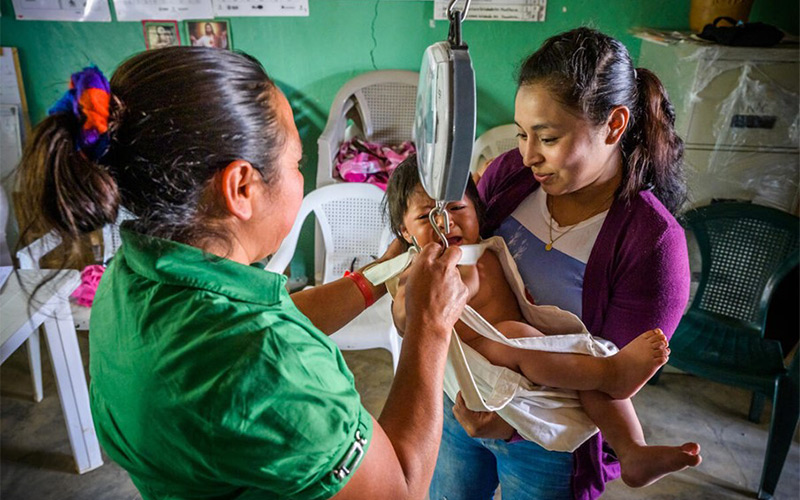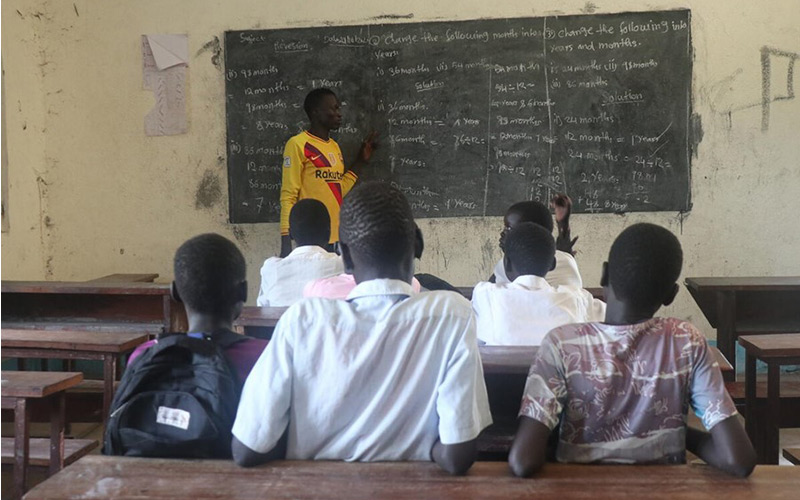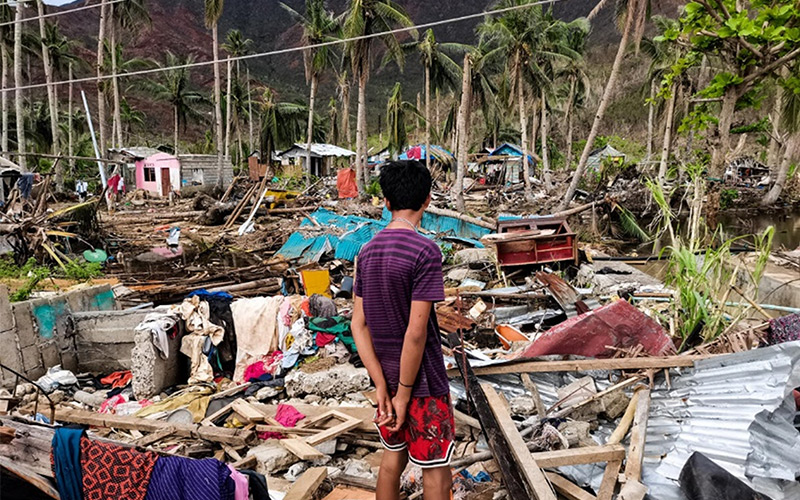Causes of poverty are both constant and changing. They increase, worsen and pervade in many parts of the world, which is why poverty remains a huge problem to this day.
Working together, the world’s countries have been making progress in poverty reduction in the last 25 years. But several global concerns such as climate change, conflict, debt and the ongoing pandemic are threatening to reverse the results.
In 2020, global extreme poverty rose for the
first time in over 20 years. People who have escaped extreme poverty could be forced back into it. Also, middle-income countries such as India and Nigeria may now be home to about
80 per cent of the world’s “new poor”.
Understanding the causes of poverty, and knowing how to address them, is critical if we are to make a difference in the fight toward its eradication.
Why are so many people living in poverty? And what can we do to help? These questions are important to answer, whether you’re a government, a world body or a caring individual.
In this article, we explore 10 major causes of poverty around the world. We explain how these causes affect the lives of millions of people. And we discuss what can be done to confront them.
What are the main causes of poverty?
- Lack of access to clean water and nutritious food
- Lack of access to basic healthcare
- Inequality or social injustice
- Conflict and instability
- Lack of education
- Lack of access to jobs and livelihood
- Poor basic infrastructure
- Climate change
- Lack of government support
- Lack of personal safety nets
Approximately
700 million people – or nearly 10 per cent of the world’s population – are still living in extreme poverty. In 2021, the World Bank predicted that the number could increase by
as many as 150 million by the end of that year due to the effects of the COVID-19 pandemic and climate change.
There’s a lot we can do to reduce poverty globally, even with multiple challenges to confront. But first, we need to understand
what poverty is – and what causes it.
1. Lack of access to clean water and nutritious food
Water and food are two of the most essential needs of every person. But:
- Up until 2019, some 2.2 billion people still lacked access to clean drinking water at home.
- Approximately 4.2 billion people did not have safe sanitation services because toilets were either unsafe or limited.
- More than 820 million people globally did not have enough food to eat.
- Severe acute malnutrition is the direct cause of death for 2 million children every year.
While poverty is often named as a cause of hunger, hunger is also a cause of poverty. It’s a vicious cycle that prevents many people from improving their lives. It’s difficult for anyone to work long hours and travel long distances to work if they don’t have enough to eat or are constantly ill from waterborne illness.
2. Lack of access to basic healthcare
Half the world’s population does not have access to basic health services. Every year, more and more families are driven to poverty because of health expenses.
Around 800 million people spend at least 10 per cent of their household budgets on health expenses. Allocating that money is impossible for the 100 million people living in extreme poverty, on just
$1.90 per day or less.
Poor health is another major contributor to poverty. Frequent illness can prevent a person from succeeding in school or holding down a job. Lack of healthcare clinics, trained professionals and medical supplies in a region worsen the problem.
 Even the most basic healthcare can help a child survive and thrive. But in 2020, an estimated 5 million children under the age of five died, mostly from preventable and treatable causes. Approximately half of those deaths are newborns. In 2021, Afghanistan, Somalia and the Central African Republic topped the list of countries with the highest infant mortality rate, respectively. Photo: Jon Warren
3. Inequality or social injustice
Even the most basic healthcare can help a child survive and thrive. But in 2020, an estimated 5 million children under the age of five died, mostly from preventable and treatable causes. Approximately half of those deaths are newborns. In 2021, Afghanistan, Somalia and the Central African Republic topped the list of countries with the highest infant mortality rate, respectively. Photo: Jon Warren
3. Inequality or social injustice
‘Inequality’ happens when one group has fewer resources and opportunities than others. It can be caused by factors like gender, race, economic situation, social status, age and physical ability.
Gender discrimination remains a pervasive form of inequality in many parts of the world. Examples include the underrepresentation of women in running their countries (only 24 per cent hold office in national parliaments). In addition, it’s much harder for women to own property such as agricultural land (globally, only 13 per cent is women-owned).
There are also limiting cultural factors that discriminate against girls and women. In many of the world’s poorest countries,
girls and women eat the least, last, and of the poorest-quality food. In 18 countries,
husbands can prevent their wives from working. As many as
49 countries still lack laws protecting women against domestic violence.
Inequality perpetuates poverty when people’s rights are ignored or violated. It robs them of the power to make their own decisions and improve their living conditions.
4. Conflict and instability
Conflict and instability are among the most common causes of poverty in the world today. Conflict can refer to an armed struggle or protracted violence. It affects a nation’s people like in the regions of Syria, Myanmar, Ethiopia, South Sudan and Iraq, to name a few.
Whether conflict happens across borders or within a country, people’s lives can be devastated, especially when forced to flee to safer places. For children, this displacement can mean months or years of missed education. Adults often lose jobs, careers and livelihoods.
Displacement due to armed conflict and violence can cause poverty or make it much worse. In Syria, for example, more than a decade of conflict has forced half the population to flee their homes.
There are more than 5.5 million refugees in the region, while hundreds of thousands more are displaced across 130 countries. At least 70 per cent of these refugees are
living in total poverty, having no access to food, water, and basic services.
 In South Sudan, children who’ve lost critical schooling due to conflict are working to catch up in this remedial class. Photo: Scovia Faida Charles
5. Lack of education
In South Sudan, children who’ve lost critical schooling due to conflict are working to catch up in this remedial class. Photo: Scovia Faida Charles
5. Lack of education
Lack of education does not automatically make one poor, but depending on one’s circumstances, it can contribute to perpetuating the cycle of poverty.
Many of those living in extreme poverty have limited education because they have to prioritize other basic needs. For others, schools are very far off, or there
aren’t enough teachers, classrooms and learning materials. There are also instances where culture prevents girls from going to school.
Education has the potential to help people all over the world break free from poverty. According to a
UNESCO report, 171 million people could lift themselves out of poverty if only they had basic reading skills. People who can read, write and do math are more likely to have success starting their own business, for example. They in turn can hire others, improving opportunities for multiple families.
6. Lack of access to jobs and livelihoods
One aspect of the so-called
‘poverty trap’ is the lack of access to jobs and other forms of livelihoods. But the solution is not as simple as addressing unemployment or underemployment.
Globally, factors such as climate change and conflict can play a devastating role in destroying jobs and lives. Economies can’t thrive amidst extreme drought, for example, or ongoing civil unrest. People forced to migrate may struggle to find work, particularly in situations like refugee camps.
In many of the world’s regions, lack of jobs is not the only concern. Once employed, many people face challenges such as
dangerous working conditions, exploitation,
discrimination and unfair pay. Addressing these issues requires resources and commitment, both within the country and all along
global supply chains.
 A homeless elderly woman in Afghanistan takes on several jobs daily such as baking bread, breaking pistachios and doing other people’s laundry to support her family. Photo: World Vision Afghanistan Staff
7. Poor basic infrastructure
Lack of infrastructure
A homeless elderly woman in Afghanistan takes on several jobs daily such as baking bread, breaking pistachios and doing other people’s laundry to support her family. Photo: World Vision Afghanistan Staff
7. Poor basic infrastructure
Lack of infrastructure can keep people in poverty, affecting the economic strength of communities and entire countries. A few examples of basic infrastructure are roads, electricity and water networks, railways, mass transit and telecommunications.
Without these, communities can remain isolated from the rest of the world, especially in
rural areas. A region with insufficient roads can’t form trading networks that would benefit multiple communities. Lack of access to basic services, education and employment opportunities all serve to perpetuate poverty.
8. Climate change
Climate change is a major contributor to poverty and deaths in the world. The World Health Organization projects
approximately 250,000 additional deaths between 2030 and 2050 due to heat stress, malnutrition, malaria and diarrhea.
Extreme drought can destroy harvests, forcing people to migrate to survive. Climate change is causing an increase in the number of forest fires and wildfires,
worsening air pollution and making food less nutritious.
With all these factors combined, the World Bank estimates
132 million people will be pushed into poverty over the next 10 years. The most vulnerable are from developing countries.
 Homes were destroyed in a far-flung coastal community in the Philippines after a typhoon hit in 2021. Many families already living in poverty struggled to survive the aftermath. Photo: Mong Jimenez
9. Lack of government support
Homes were destroyed in a far-flung coastal community in the Philippines after a typhoon hit in 2021. Many families already living in poverty struggled to survive the aftermath. Photo: Mong Jimenez
9. Lack of government support
Around the world, many governments lack the ability or willingness to provide support to struggling citizens. In wealthy countries like Canada, government support may include food assistance, free healthcare, low-income housing, low-income tax credits, training programs and financial assistance.
Economic welfare programs can
cut poverty by up to nearly one-half. But, without sufficient government support when people are struggling to access the necessities of life – or improve their education or job prospects – escaping poverty can be more difficult.
10. Lack of financial safety nets
Financial safety nets are resources set aside for use during emergencies or one-off expenses. Some examples are savings accounts, small loans, and insurance policies. Their main purpose is to ensure that a person or family can overcome financial difficulties that may be caused by mounting debt, sudden loss of livelihood, illnesses, natural disasters or other unforeseen circumstances.
Without financial safety nets, one huge expense can cause an individual to become poor and create
long-lasting problems spanning generations. But for those already living in extreme poverty, these safety nets are a privilege they cannot afford.
This is where other financing vehicles like
microfinancing comes in. It promotes economic empowerment for the poor and gives them a chance to lift themselves out of poverty in the long run.
Causes of poverty in Canada
A 2021 report by Statistics Canada indicated that
3.7 million Canadians, or 10 per cent of the population, are living below Canada’s poverty line. Using the Government of Canada’s Market Basket Measure, families living below the poverty line “do not have enough income to purchase a specific basket of goods and services in [their] community.”
Many different factors contribute to poverty in Canada. For many Indigenous people, the remote location of communities, combined with lack of opportunity and infrastructure, keeps thousands in poverty.
Around the country, factors such as lack of employment and affordable housing – combined with the expense of higher education and training programs – can affect many families. Some families in Canada are refugees, struggling to overcome language barriers to employment.
Additional facts about poverty in Canada:
What is World Vision Canada doing to help address the causes of poverty?
 A World Vision staff member helps distribute food supplies to survivors of the earthquake in Haiti in 2021. World Vision provides essentials such as food, water, shelter supplies and medical care in emergencies, as well as livelihood and infrastructure support to help families rebuild. Photo: Guy F. Vital-Herne
A World Vision staff member helps distribute food supplies to survivors of the earthquake in Haiti in 2021. World Vision provides essentials such as food, water, shelter supplies and medical care in emergencies, as well as livelihood and infrastructure support to help families rebuild. Photo: Guy F. Vital-Herne
The organization has a variety of programs in over 50 countries, aiming to address the main causes of poverty. Our biggest priorities include but are not limited to:
- Providing access to clean and safe water and nutritious food.
- Improving access to education and healthcare.
- Providing livelihood training and microfinance support.
- Providing essentials to people living in the world’s most dangerous places.
- Promoting child protection and increasing knowledge of child rights, as well as preventing child marriage.
How can we help address the causes of poverty?
Eradicating poverty is a tall order, but this doesn’t mean it’s impossible. As the world’s countries work together to combat poverty, you can also contribute to the cause. Here are several ways to help:
- Send most-needed gifts to children and families
Make an impact in the lives of vulnerable people by sending the most-needed gifts through the World Vision
Gift Catalogue. Some examples are emergency kits, agricultural packs or medical supplies for children and families who need them most.
You can also choose to
sponsor a child through World Vision’s child sponsorship program, providing access to essentials such as food, water, health care and education. It’s a powerful way to help them break the cycle of poverty and empower children to build brighter futures.
If you’d like to make a bigger impact or you have family and friends who also want to contribute, you can pool your funds together and partner with a community. Help them break the cycle of poverty by improving access to education, health care, food security and nutrition, as well as livelihood opportunities.
Village2Village is a multi-year partnership that works in villages from eight communities across six countries: Kenya, Bangladesh, Guatemala, Nepal, Laos and Tanzania.
Remember that you are capable of doing important work to help the world’s people break free from poverty. There are so many ways to help. Get started today!